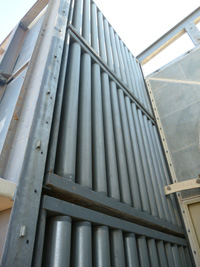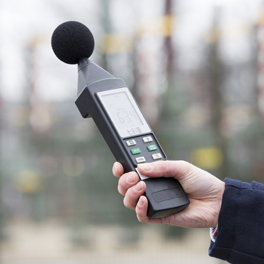ACOUSTICS
P owerful engines generate incredible acoustic energy. Immediate and cumulative damage can result in test equipment breakage, facility deterioration, structural fatigue, connector loosening, electronic component failures and calibration drifts. Acoustic, thermal and airflow requirements are critical considerations early in the design of turbine engine support equipment and jet engine test cells.
Atec has recognized experience dealing with sound attenuation around turbine engine testing facilities. Acoustic analysis, lab testing, site surveys, best practices, project experience, field installation tests, customer/operator feedback and acoustic studies are some of the methodologies applied by our technical team to acoustic design considerations. When designs are conceptualized, the Atec-Celtech-Vital Link team has unsurpassed capability in fabrication of heavy structural silencers, manufacture of precision seals and construction of engine test enclosures. Atec has professionals on our team with unmatched practical experience in worldwide field studies and project treatments for aeroengine acoustic energy. Renowned Vital Link experts now add to our acoustics and airflow pedigree.
Atec routinely designs jet engine test cells and turbine support equipment to gain frequency spectrum profiles, industrial noise approvals, meet occupational workplace noise exposure limits and avoid noise and vibration complaints. Atec also frequently performs computerized vibration modal analyses, natural frequency reviews, fatigue analyses, noise impact studies, sound surveys and on-site fine tuning. Our engineering team maintains comprehensive consideration of environment, personnel, engines & equipment, operations maintenance and safety when dealing with high levels of sonic, thermal and mechanical energy present in turbine engine test cells.
All new facilities are given an acoustic review during design. Atec is renowned for adapting larger capacity engines into existing test facilities. Acoustic and air flow considerations are usually determinants in such applications. Beyond computer analysis, Atec has 65 years of experience with hands-on utilization of accessories, components, materials, and arrangements to achieve desired acoustic and air flow outcomes.
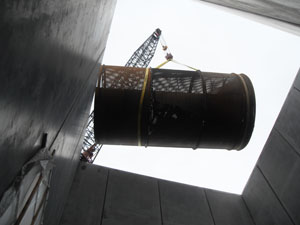
Software
Atec models the application flow field using CFD software. The CFD output is input into the acoustical model, and the acoustic field within and around the test cell application is predicted. Following this effort, any hot spots can be further studied. More complex projects will likely receive follow up detail modeling on software specific to such detected concerns or client requirements.
For acoustic modeling software Atec has access to ANSYS®, Cosmos Multiphysics®, custom MATLAB® scripts, Siemens LMS®, and Actran Acoustics® for analysis of dispersion, concentration, harmonics, reflectors, exhaust plumage, barrier transmission, silencer performance, and many other considerations. Additionally, for unique situations, Atec has access to government, industry, and university labs, test cells and respected external subject matter experts for consultation with our engineers.
Hardware
- Panels-Perforated, Insulated, Connected
- Baffles, Screens, Diffusers
- Splitters, Diverters, Deflectors
- Turning Vanes, Grates, Spacers
- Secondary Inlets, Collectors, Rings
- Augmentor Tubes, Exhaust Stacks
- Baskets, Cones, Harps, Rails
- Doors, Rain & Sun Covers, Lifts
- Bellmouths, Screens, Mounts
- Composites, Custom Concrete, Coatings
- Insulators, Isolators, Insulation
- Seals, Gaskets, Penetration Pass-Thrus
- Pressure Relief Safety Panels
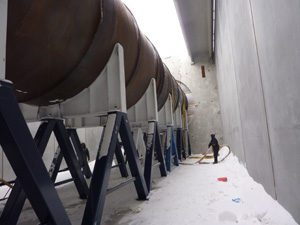
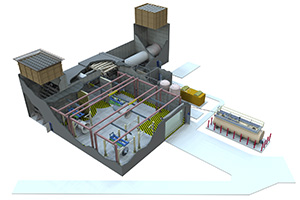
Acoustic Surveys & Tests
Atec performs many types of acoustic studies, including:
- Surveys and tests of the impact of noise on structures within a facility, including reflective noise limitations of engines and systems within a test cell
- Surveys and tests of the impact of noise propagated to the environment from a fixed installation, such as a test cell. Also known as an environmental impact study. Atec can also perform environmental impact studies of aircraft around air bases
- Surveys and tests of noise within a structure to determine “reasonable” noise environments. These can be used to determine human sound exposure and hearing protection requirements for humans in accordance with OSHA standards
Acoustic Designs
Atec incorporates acoustic consideration into the design of many of its products. For example:
- Atec’s Phoenix Series test cells underwent extensive design and testing review to ensure sound attenuation external to the facilities. The metal wall panels used around the engine room have been independently tested and certified to a Sound Transmission Class (STC) ratings of 42 and 54
- Acoustic design and analysis of large commercial test cells to determine concrete composition and isolation/insulation for controlling sonic energy transmission, as well as required acoustic treatment inside the test cell, inlet, and exhaust
- Working environment analysis to ensure safe and comfortable conditions for personnel in an around test cells and control cabins. Atec incorporates sound attenuating materials and design elements in order to meet OSHA Regulation 29 CFR 1910.25 Occupational Noise Exposure and PE-1 Machinery and Equipment Standards Section I12.
